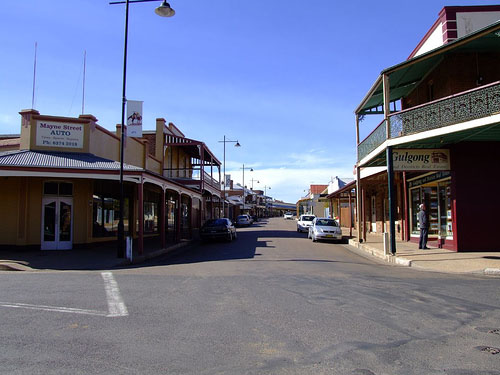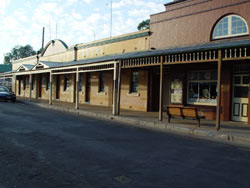Share this page:
>
Gulgong was a small town that grew rapidly during the Australian goldrushes of the 1850s.
After the goldrushes finished, most of the population left the town, and many of the original buildings were left standing, never re-developed and may still be seen in the streets of Gulgong today. (There are around 130 buildings in Mudgee that have been classified by the National Trust.)
Here are some pictures of Gulgong and its fascinating old buildings:

Mayne Street, Gulgong.
(Many of these buildings are over 130 years old.)

Prince of Wales Opera House, Gulgong
One of the buildings that you may see in Gulgong is the Prince of Wales Opera House (see picture above), where the Australia's most famous opera singer, Dame Nellie Melba, once sang.
Henry Lawson, one of Australia's greatest poets and short story writers, lived in Gulgong for several years and in Gulgong you may visit the Henry Lawson Centre and view the greatest collection of his writings and memorabilia that exist outside of the State Library of New South Wales (which holds the greatest collection).
Gulgong's Pioneers Museum contains a massive documentation of 19th century in Australia. Tens of thousands of objects from the daily life, transport, clothing, tools, life on the goldfields, and other areas of the 19th century are on display. Many people visit Gulgong just to visit that museum!
Gulgong is often referred to the "town on the ten dollar note" as images of goldrush-era Gulgong from the Holtermann Collection of photographs (which were taken in the 1870s, then thought lost and finally rediscovered in 1951) were printed on the first edition of Australia's ten dollar note which was issued in 1966.
Gulgong has an active local craft community (especially in the fields of ceramics and jewelry) and you may see their works on display at the Cudgegong Gallery and the Australian Wildflower Jewellery Gallery.
Interesting festivals held in Gulgong include the Gulgong Folk Festival (every January) and the the Henry Lawson Heritage Festival (every June).
Share this page:
Author: David Paul Wagner
(David Paul Wagner on Google+)
|